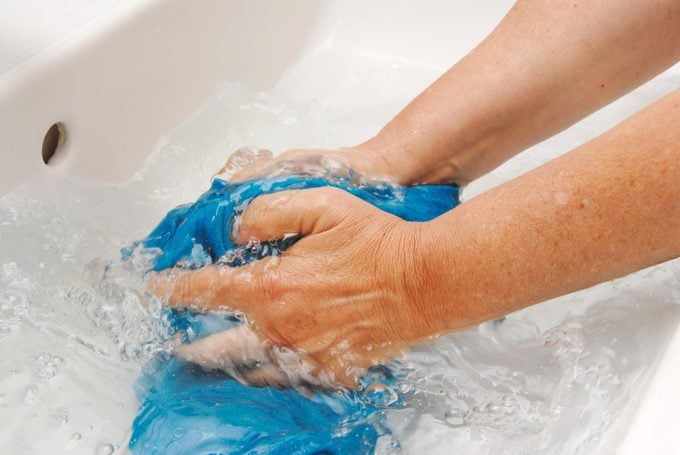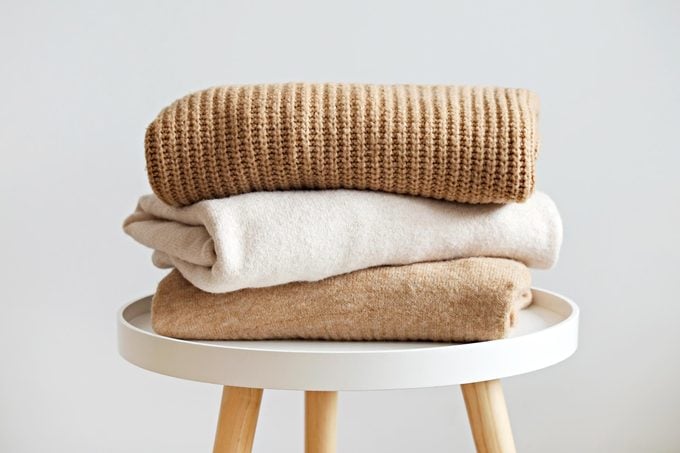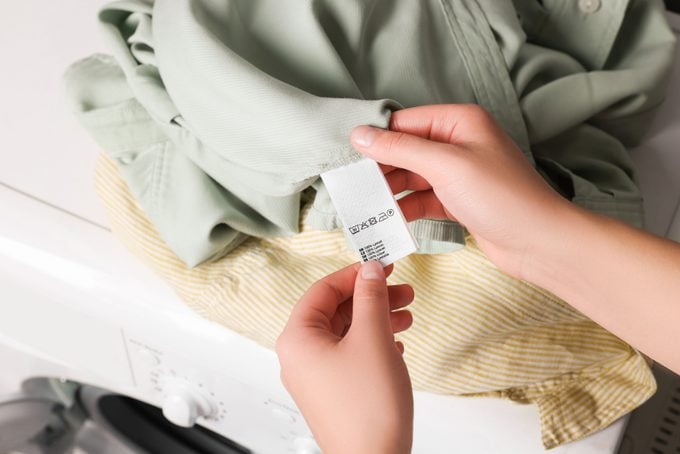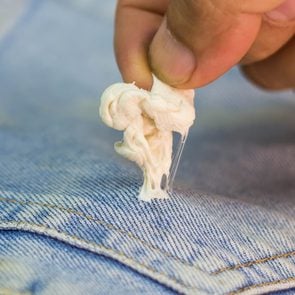How to Unshrink Clothes—and Prevent Them from Shrinking in the First Place
Updated: Apr. 19, 2024

All is not necessarily lost! Save your favorite sweater by learning how to unshrink clothes with these expert-recommended steps.
It happens to the best of us. You (or your well-intentioned family member) reach into the laundry basket and unknowingly toss your favorite sweater in the dryer on high heat, and it comes out a few sizes too small, too short or totally misshapen. At some point in your laundering life—even for those who know how to do laundry the right way—it is inevitable that you will accidentally shrink a piece of clothing. “Even following recommended care instructions can change the dimensions of a garment or home textile,” says Mary Gagliardi, aka Dr. Laundry, Clorox’s in-house scientist and cleaning expert. But all is not necessarily lost! Experts say it’s possible to learn how to unshrink clothes … if you follow a few strategic steps.
Even better? Properly reshaping a sweater or other shrunken garments is easier than you think. Reader’s Digest spoke to Gagliardi and LaundryTok expert Melissa Dilkes Pateras, author of A Dirty Guide to a Clean Home, to get the 411 on rescuing your favorite clothing and preventing this situation in the first place. Read on for their tips and tricks to unshrink any garment ASAP.
Get Reader’s Digest’s Read Up newsletter for more cleaning, tech, travel, humor and fun facts all week long.
About the experts
Reviewed for accuracy by: Mary Marlowe Leverette. |
Why do clothes shrink?
The main culprit is fiber type, according to Gagliardi. Natural fabrics, such as cotton and linen, are more likely to shrink because of their moisture-absorption properties. Natural animal-hair fibers—think: wool and cashmere—absorb moisture too, but they also “felt,” a permanent interlocking of fibers that makes a clothing item appear smaller once wet, which can be mistaken for shrinking. “Aggressive agitation in warm or hot water of a wool item is all that’s needed to felt wool fibers,” Gagliardi says. How much tension yarn is under when the fabric is woven, knitted or processed will also affect shrinkage; the tighter the knitting, the less likely it is to shrink.
The overall quality of the clothing plays a role in shrinkage as well. Provided you follow the instructions on the laundry care tag, a high-quality garment or fabric should maintain its original shape and good dimensional stability—meaning you should be able to wash and dry it without its size being impacted. Higher-quality manufacturers also use special finishes and production techniques to prevent shrinkage.
How to unshrink clothes

Gagliardi recommends following these steps to unshrink your clothes.
- Fill a sink or tub with lukewarm water.
- Soak your shrunken garment for up to 30 minutes to loosen fibers.
- Remove the item from the water, and gently squeeze the water from the clothing.
- Lay the item on a flat towel and roll it up, gently squeezing the wet item until it is damp.
- Lay the item on another dry, flat towel, and gently stretch it back to its pre-shrunk size. (Optional, to help the garment keep its shape: Once the damp garment is stretched to the proper size, fabric-care expert Mary Marlowe Leverette recommends placing a piece of heavy cardboard under the dry towel and using stainless steel T-pins along the garment’s edges. Stainless steel pins will not leave rust stains on the clothing.)
- Allow the item to air-dry.
This method will help to unshrink clothes even after they have been shrunken for months—as long as you don’t continuously wash and dry the items after they shrink, according to Pateras. Repeated laundering “will only constrict the fibers more,” she says.
Should you repeat the process if it doesn’t work the first time? No. “If you can’t gently pull a wet garment back to its original shape, trying again likely won’t yield success,” says Gagliardi. “This isn’t like stain removal, where repeating a treatment can get a stain all the way out.”
Can hair conditioner help to unshrink clothes?
A viral TikTok hack claims that a capful of hair conditioner can make the unshrinking process even easier. Pateras vouches for this method, because she’s used it a few times herself—including when her daughter accidentally shrank her favorite sweater after putting it in the dryer. The steps are simple:
- Fill a bucket, tub or sink with lukewarm water (enough to cover the item).
- Pour a quarter cup of hair conditioner or baby shampoo into the water. Mix well.
- Place the shrunken item in the mixture and soak it for 20 to 30 minutes, moving it around every few minutes to relax the fibers.
- Lay the item on a clean, dry towel and roll it like a burrito while gently pressing to remove excess water.
- When the item is damp but no longer soaking wet, unroll it and place it on a separate dry towel.
- Gently pull and stretch the item by hand. “Now that the fibers are relaxed, the goal is to hand-work it back into its original size and shape it before it fully dries,” Pateras says. If you are unshrinking a sweater, you can also stuff towels inside the arms to stretch them out.
- Stop once the item reaches the size and shape you desire.
- Hang the item in a well-ventilated space to air-dry.
Keep in mind that while anecdotal evidence suggests this method works, Gagliardi doesn’t necessarily endorse it. The issue? Leaving the conditioner on your clothing without rinsing it out can attract dirt. Simply using water on its own can do the trick, she says, because “moisture from water is what’s needed to break the hydrogen bonds in the cotton and allow the fabric to be pulled back to its original shape, or at least close to it.”
Other tips to unshrink every type of fabric

Every fabric has its own quirks when it comes to figuring out how to unshrink clothes. Here’s what you need to know about different materials and clothing items.
Cotton sweaters
Worried that you might shrink your favorite cotton sweater, even though you’re being super careful with it? Trace an outline of it on paper before you wash it. This will help you see if it shrank, and if it did, you can use the guide to help you reshape it to its original dimensions following the steps above. “Many sweaters need to be reshaped after washing—that means giving them a few gentle tugs (on the sleeves, across the body and along the length) to remove any shrinkage and get them back to their original shape,” Gagliardi says. “Then you lay them flat to dry, as directed on the care label.”
It’s important not to wait until you dry a cotton sweater to assess it for shrinkage—by then, it may be too late. “You can always re-wet the sweater and try reshaping it, but you save time by doing this after washing and before drying,” Gagliardi adds. Note that if you have a sweater with a care label that says “tumble dry” and it shrinks, it was poorly made!
Wool knits
Learning how to unshrink wool can be simple. Wool knits that have not felted (which is permanent) can be stretched out if you softly tug the fabric while it is damp, Gagliardi says.
However, she notes that you should always do your best to prevent felting from occurring in the first place by following your wool garment’s care instructions. “If it says ‘dry clean only,’ then that’s your only choice for fabric care. If hand-washing is allowed, the sweater should be washed and rinsed in the same lukewarm water temperature,” she says. Additionally, agitation should be kept to an absolute minimum. “Instead of swishing or wringing the sweater, the cleaning solution should be gently squeezed through the fabric. Hot water, agitation, twisting and wringing all contribute to felting, so they must be avoided.”
Cashmere
Cashmere, like sheep’s wool, has barbs on the surface of the individual fibers. “When agitated too much during washing, the barbs lock together, causing felting shrinkage, which is permanent,” Gagliardi says.
However, if a cashmere sweater has relaxation shrinkage, it can gently be pulled back to its original shape while it is wet before you lay it flat to dry. Again, make sure you know the specific rules of washing cashmere before attempting to launder your item.
Can all shrunken clothing be fixed?
Unfortunately, no. Whether or not an item can be saved depends on both the type of shrinkage and the type of fabric you’re dealing with. That’s because to bring back clothing to its original shape and reverse relaxation, you need to apply tension, and “this is easier to do with cotton fabrics,” Gagliardi says. “Think of the way the waist band on a pair of blue jeans fits tightly when you first put them on after washing, only to have it stretch out after a few minutes.” But for cotton clothing that doesn’t fit tightly (think: a T-shirt), you need to apply tension manually by pulling on the garment to unshrink it.
And now for the bad news: With merino wool, cashmere and other animal-hair fibers that haven’t been chemically treated or blended with a synthetic, shrinkage is the result of felting, says Gagliardi, and “reversing it is usually impossible because felting is a permanent physical change.”
How can you prevent shrinking in the first place?

For starters, always read the care label of an item, and make sure to wash and dry it correctly. With cotton items, lowering the wash temperature and air-drying will help prevent a garment from shrinking due to “relaxation.” Blue jeans and other heavy fabrics can be hung by the hems on pants hangers to line-dry; the weight of the damp fabric will naturally lengthen the legs. Less sturdy lightweight fabrics (think: sweaters) should lay flat to dry, since the weight of the wet item can cause shoulder seams to rip or stretch if they’re hung to dry.
What materials don’t shrink?
Polyester and other synthetics are not prone to shrinkage. “Polyester fabrics are less likely to shrink because the fibers themselves are hydrophobic and don’t change morphologically when in water (unlike natural fibers),” explains Gagliardi. The same is true of some machine-washable wools, which are blends that utilize a small percentage of polyester or acrylic to stabilize the wool and prevent shrinkage.
However, these fabrics can experience relaxation shrinkage, especially if they’re not properly made. Washing heat-set synthetics in water that is hotter than the temperature used in the heat-setting process can cause shrinkage that’s irreversible. That’s why following care labels—including water-temperature directions—is so essential.
You’ll also have better luck at avoiding shrinkage with garments whose production includes a preshrinking step (which is really just prewashing). That’s because “most shrinkage occurs the first time an item is washed,” Gagliardi says. Already washed means already shrunken!
Why trust us
At Reader’s Digest, we’re committed to producing high-quality content by writers with expertise and experience in their field in consultation with relevant, qualified experts. For this piece, Leah Groth tapped her experience as a seasoned home and cleaning reporter, and then Mary Marlowe Leverette, a fabric-care, stain-removal and laundry expert with more than 40 years of industry experience, gave it a rigorous review to ensure that all information is accurate and offers the best possible advice to readers. We also relied on reputable primary sources, including LaundryTok expert Melissa Dilkes Pateras and Clorox scientist Mary Gagliardi (aka Dr. Laundry). We verified all facts and data and backed them with credible sourcing, and we will revisit them over time to ensure they remain accurate and up to date. Read more about our team, our contributors and our editorial policies.
Sources:
- Mary Gagliardi, aka Dr. Laundry, Clorox‘s in-house scientist and cleaning expert; email interviews, August 2021 and October 2023
- Melissa Dilkes Pateras, LaundryTok expert and author of A Dirty Guide to a Clean Home; email interview, Jan. 5, 2024



